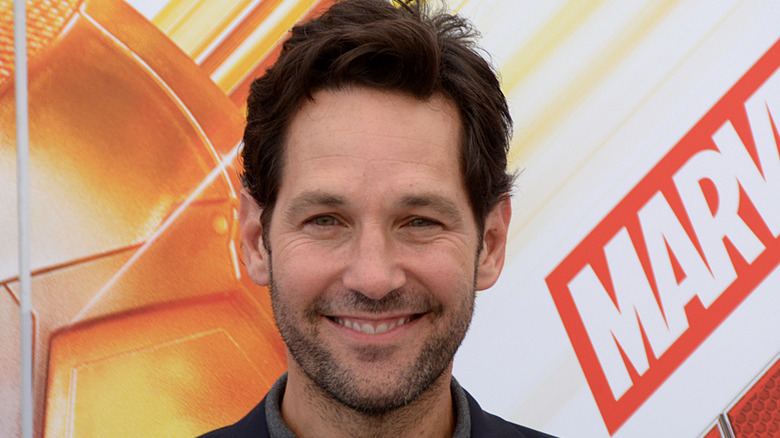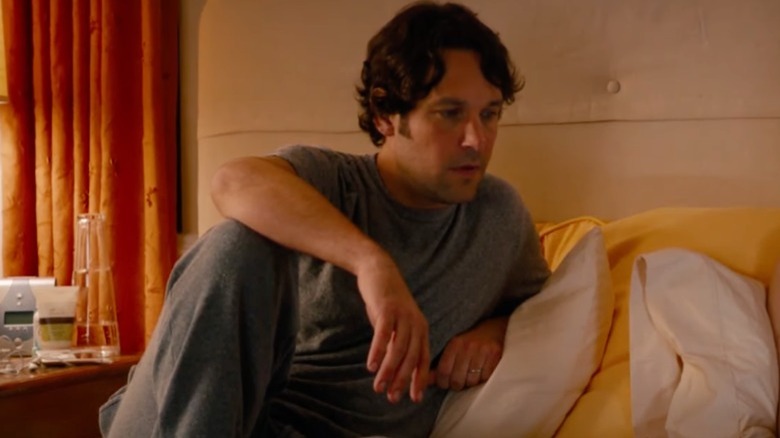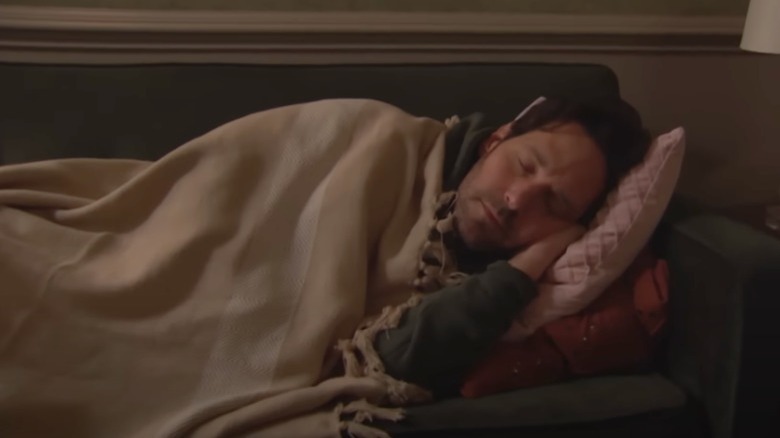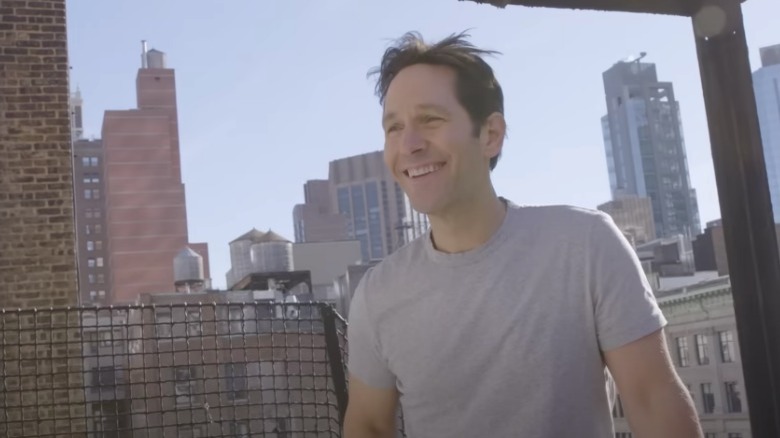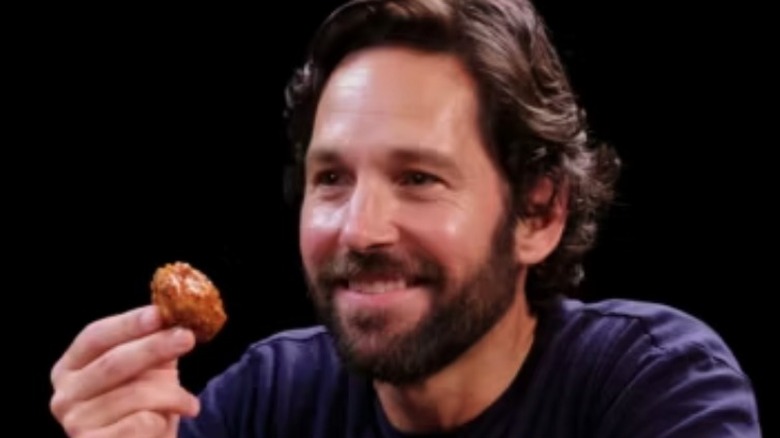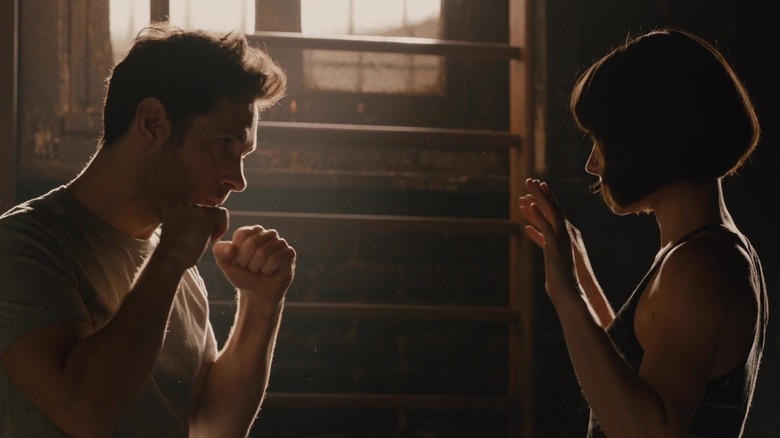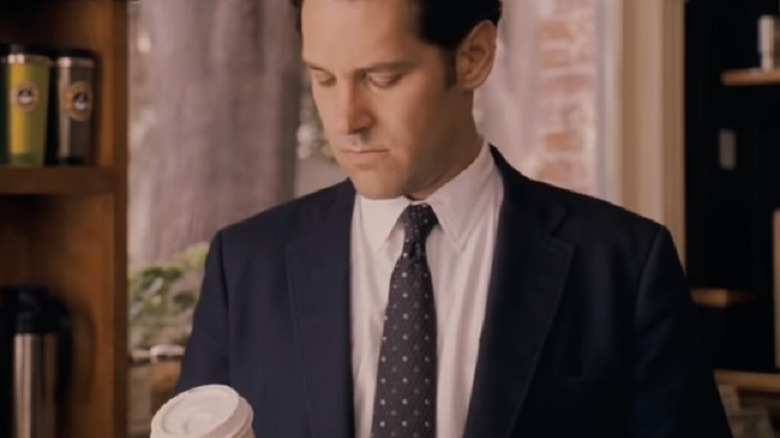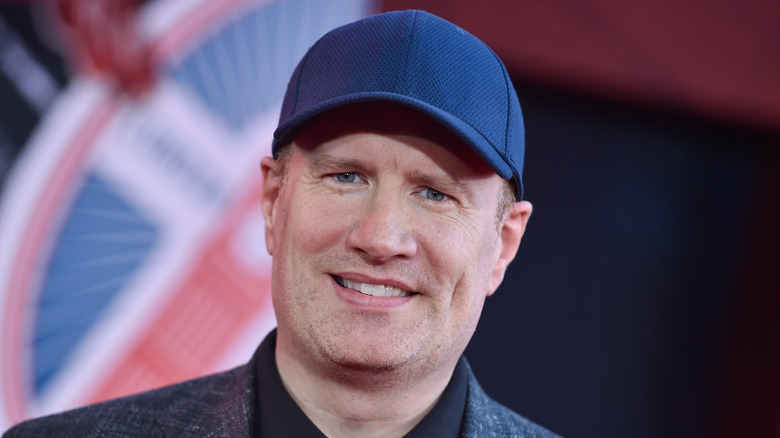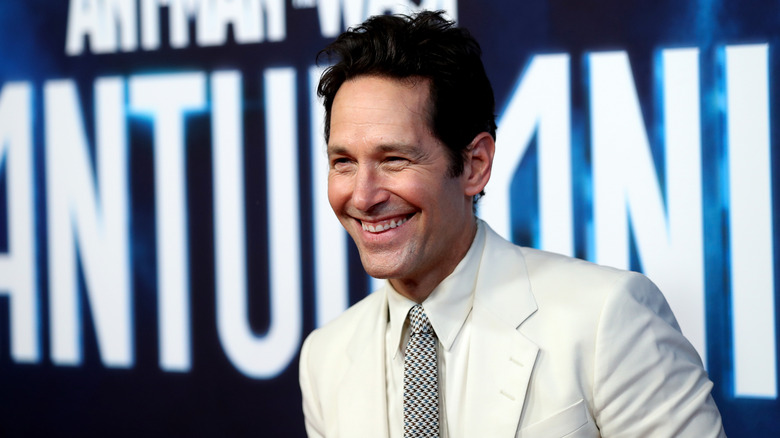How Paul Rudd Got Ripped To Play Ant-Man
Paul Rudd's seemingly everlasting youth is a topic that comes up often in Hollywood. Fellow actor Seth Rogen even joked on Jimmy Kimmel Live that many would think he was older than Rudd when he is actually 13 years his junior. As well as his youthful appearance, when you think of Paul Rudd, the image of him as Scott Lang aka Ant-Man in the Marvel Cinematic Universe will likely spring to mind. Having appeared in several films in the expansive franchise, Rudd has made the size-changing superhero his own. However, Ant-Man has not always been the go-to role for the actor.
For years before he landed the role of Ant-Man in 2015, Rudd was known for his comedic acting — frequently collaborating with director Judd Apatow" — in films like "Anchorman: The Legend of Ron Burgundy," "This Is 40," "Forgetting Sarah Marshall," and countless others. Whether as the love interest, or goofy supporting character, his previous work didn't necessarily see him in many intense situations, and there wasn't the need to show off his physique. But when you're a superhero in the MCU, physical prowess becomes much more important, so Rudd had to make sure he was in shape for the role.
Getting that shredded physique doesn't come easily, however, and Rudd worked extremely hard to make sure that he could meet the physical demands of the role and look the part. From his workouts to his dieting and sleep schedule, we take a look at Rudd's journey to becoming ripped for the role of Ant-Man.
His body used to be seen as a joke
There's no denying that there is a big difference between the physical demands in a Judd Apatow comedy and an MCU movie, and one of these will require the actor to be a little more ripped than the other. Most of the time in his previous films, Paul Rudd's body was either not particularly important to the plot or was put on display in a joking manner. In fact, before his appearance in "Ant-Man," it was rare that he would have a shirtless scene in a film.
When Rudd got the cover of Men's Health at the beginning of 2023, he spoke about how most people would be surprised or confused that he was going to be playing a superhero. This is mostly because the niche he had occupied for so long was just about as far from the MCU as he could be. In the interview, Rudd said, "Every shirtless scene I had ever done was for comedy's sake. I had no business doing a shirtless scene [in a superhero movie]." That is what really inspired Rudd to start training for the "Ant-Man" films — he figured he would be doing a shirtless scene at some point and wanted to get his physique comparable to some of the other actors already playing heroes in the franchise. His year-long training began, and the world was introduced to the new Paul Rudd thanks to a regime of fitness, nutrition, and wellness-boosting activities.
The importance of sleep
Surprisingly, Paul Rudd's most important part of his fitness routine is not the weight lifting, cardio, or diet plan. Instead, what Rudd prioritizes more than anything else is his sleep schedule. Getting plenty of rest is what he credits as his own fountain of youth, the secret to staying healthy, and a trick to a better life as a whole. In his interview with Men's Health, Rudd said, "The most important part of training is sleep. People will set their alarm and then sleep for four hours and they'll get up so that they can train. They're doing themselves a disservice."
Rudd's logic is backed up by science, though, and he is correct in believing that your sleep schedule should be fixed before worrying about dieting or working out. According to the Sleep Foundation, most adults need at least seven to nine hours of sleep each night, yet it is reported that almost one-third of Americans get less than six hours per night. When your sleep is off, your body is more susceptible to negative health conditions like diabetes, heart disease, and more. The Sleep Foundation also noted that lack of sleep also causes people to overeat and choose unhealthy foods, as well as not practice working out safely and not having enough time to recover in between workouts. So before you can have the healthiest diet plan or workout in the best way, you have to adjust your sleep schedule and give your body time for recovery and rest.
He found a nutritionist and trainer
Embarking on a health journey can involve a number of serious lifestyle changes, and one important aspect of this is diet and nutrition. Speaking with Men's Journal about the steps he took to improve his diet, Paul Rudd said that he, "was one of those people who always wanted the results, but never wanted to put in the work." However, he recognized that this had to change in order to effectively train for the role of Ant-Man, so Rudd hired a nutritionist and trainer to professionally handle his diet plan and fitness regime and keep him on track.
His nutritionist was Carlon Colker, the CEO and Medical Director of Peak Wellness of Greenwich, CT. His practice includes internal medicine, sports medicine, and nutrition. He has published work on human performance and nutrition, and he has become known as a "go-to" doctor for actors undergoing challenging roles that require a body transformation.
According to Men's Journal, Colker recommended a trainer for Rudd — Richard Louis, the owner of FitSpace NYC. Louis similarly specializes in body transformation and is known for his innovative and intense approach to workouts. Louis' reputation shows his trainees getting results within short periods of time, and many of those who work with him are notable actors preparing for roles in film and television, like Rudd.
Balancing discipline with living his life
Even though Paul Rudd hired a nutritionist and trainer, he emphasized that he did not want to change his routine too drastically. The key, he found, was balancing discipline with just living his life and still being able to enjoy food. He made conscious decisions when eating, ensuring he was consuming foods that would be good for his body, help fuel him through his workouts, and were still delicious. There were still foods he had to avoid, however, like bread, fried foods, and sugar to a certain extent (via Men's Health).
Per his "Eat Like" interview with Men's Health, Rudd said he loves french fries, beer, and pizza and admitted that even when you're disciplined with your diet, occasionally you can just have a slice of pizza with friends. Additionally, Rudd explained that he doesn't take any supplements or multivitamins to correlate with his meal choices, feeling that the diet plan he has created provides him with all the nutrients he needs for his daily life.
His typical daily food intake includes eggs, oatmeal, coffee, protein shakes, nuts, salad with protein, sweet potatoes or rice, and another protein with an ample serving of vegetables. This way, Rudd's diet could remain relatively normal and still fuel him, Rudd's trainer, Richard Louis, said to Men's Journal: "This was about making a lifestyle for Paul, so we didn't want to do anything too extreme with his diet. The focus was on cutting down on bad carbs, while adding plenty of protein and good fats."
Focus on the fundamentals
When you read about some of the severe lengths actors have gone to for a role, it is hard to try and understand why anyone would want to push their body beyond its limits. However, just as Paul Rudd didn't want to do anything too extreme with his diet, the same goes for his workout routine too. According to Men's Journal, Rudd decided to hone in on the fundamental lifts instead of doing anything too wild. The fundamental lifts include the deadlift, bench press, and squat, and they can help you burn fat and increase muscles when executed properly (via Men's Journal). These can be done by increasing weights in order to stretch the difficulty and get the most out of your workout.
Rudd's workout specifically contained three circuits, centered around these three fundamental lifts. Each circuit required five rounds to be completed with 45 seconds of rest in between. For Circuit A, Rudd used the Smith Machine Incline Press (bench press) for 15 reps, the EZ-Bar Curl for 15 reps, and hanging knee raises for 25 reps. For Circuit B, Rudd did the dumbbell bench press for 12 reps, the dumbbell hammer curls for 15 reps, and side plank crunches for 20 reps on each side. Finally, for Circuit C, Rudd completed 20 reps of cable flys, 15 reps of double bicep cable curls, and 25 reps of physioball crunches. While still an intense workout, the focus on the fundamentals ensured Rudd achieved the ripped physique needed for the role.
Coffee and Cardio
In addition to his diet plan and focus on the fundamental lifts, Paul Rudd also worked in a good amount of cardio. Rudd is a certified coffee lover who continued to drink coffee throughout his fitness journey. He told Men's Health that he starts every morning with coffee and a side of cardio, saying, "I do cardio before I eat anything. I never would've done that before [Ant-Man]." This cardio typically lasted an hour each day, and then he would eat breakfast and hit the weights. Three times a week, though, Rudd would add an extra half an hour of cardio to help expedite his fitness process.
There are significant benefits to doing cardio first thing in the morning before eating anything. Cardio is one of the only workouts that is always beneficial to do two-a-days with. Some people lift twice a day but lack the time to accurately recover their muscles and effectively harming the fitness process. Getting cardio in on an empty stomach in the morning helps you to burn primarily fat, but also helps with your cardiovascular health. Morning cardio helps with your metabolism, too, by setting the tone for fat burning and eating throughout the day. This then leaves you time in the evening for lifting, which, according to 1Up Nutrition, has some mental advantages. Rudd uses this method for his workout, so in addition to the science of it all, there is living proof that this is effective.
Kevin Feige was impressed
Anyone who has seen "Ant-Man" — or at least the shirtless picture of Scott Lang cleaning his battle wound — knows that Paul Rudd's fitness journey greatly paid off for the film. But Rudd was left feeling a bit dejected after his big shirtless scene was cut from the first "Ant-Man" film and turned into just a quick shot of Rudd's torso.
Rudd told Men's Health, "On one hand, I was annoyed because I put in a year's worth of hard work. On the other, if I had to look at myself shirtless in a Marvel movie, I would just want to make fun of it in every single way." In the context of the film, the scene proved disposable and for some, this might prove to be a bit of a deterrent to staying disciplined.
However, this soon turned into praise, as the quick shirtless scene gained a lot of fans on the internet. Additionally, there was one seal of approval Rudd got that made everything a bit better. Richard Louis, Rudd's trainer, said to Men's Journal, "Kevin Feige, the president of Marvel, came up to me and said how impressed he was with the way Paul looked. I have to say, that felt pretty cool." This certainly helped the actor with training motivation for future Marvel films.
He learned about himself
Even though the physical transformation played an important part in preparing Paul Rudd to play a superhero, more importantly, he learned a lot about himself through his fitness journey. According to the Mayo Clinic, fitness can actually be a huge mental health booster. Regular exercise can ease depression and anxiety because of the feel-good endorphins released during working out. It also simply takes your mind off of worries and focuses it on what you are doing for your body, which can help in the moment. Exercising can also help you gain confidence, get more social interaction, and can be a healthy coping mechanism.
Rudd told Men's Health that he has learned so much about how his body reacts to food, how it reacts to exercise, where he is happiest, and how much it impacts him mentally. He said, "If I'm in this suit, running around playing a character who's supposed to be a superhero, I just feel better. And I feel less like an impostor." His transformation certainly paid off physically, but in all of his interviews regarding his fitness journey, Rudd emphasizes how he has become happier since incorporating more fitness into his life — and nothing is more important than the happiness and mental health factor of it all. Rudd continues this zen attitude toward fitness and it continues to pay off — as fans can see in his continued appearances in the Marvel Cinematic Universe.
